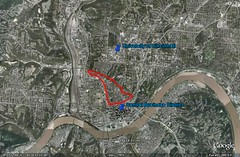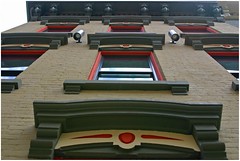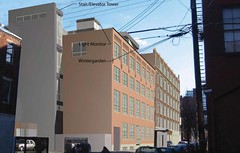Revitalizing Cincinnati’s Over-the-Rhine (Part 4: making it green)

Posted June 23, 2009 at 1:28PM
This is the final installment of my miniseries about Cincinnati's remarkable Over-the-Rhine neighborhood, potentially a national model for smart, green revitalization. For previous posts in the series, visit Part 1 (the legacy and the challenge), Part 2 (building on the neighborhood's assets), and Part 3 (making impressive progress). Today we'll look at the prospects for the neighborhood's recovery to be successful environmentally.
The reason that revitalizing Over-the-Rhine should be just as important to environmentalists as it is to historic preservation, economic recovery, and social equity is that revitalizing such a centrally located district is inherently green, even if you aren't trying to make it so. Let's revisit some maps that accompanied the earlier posts:
On the left, we see OTR outlined in red, as central as can be, adjacent to Cincinnati's central business district and just south of the jobs-rich uptown University district. On the right, we see the pattern of per-capita carbon dioxide emissions from driving in metro Cincinnati. The neighborhood is in the lightest color, signifying the lowest emissions, in sharp contrast to the region's outlying areas with much higher emissions rates.
The main reason is that households in outlying areas simply drive a lot more than their inner-city counterparts, because for residents of outlying areas destinations are more spread out, transit service is less available and convenient for most people, and there is little within walking distance.
Here's a really wonky bar graph, borrowed from my presentations, that takes us inside the research a little. 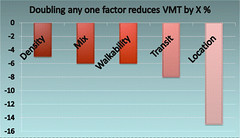 Based on a meta-analysis of the published literature on travel behavior (publication pending), it shows the five major land-use factors that can reduce the amount of driving people need to do, and their importance relative to each other and the total. A central location is by far the most helpful to reducing driving rates, followed by the presence of transit service, neighborhood walkability, a mix of commercial and residential locations in the neighborhood, and neighborhood density.
Based on a meta-analysis of the published literature on travel behavior (publication pending), it shows the five major land-use factors that can reduce the amount of driving people need to do, and their importance relative to each other and the total. A central location is by far the most helpful to reducing driving rates, followed by the presence of transit service, neighborhood walkability, a mix of commercial and residential locations in the neighborhood, and neighborhood density.
OTR has all of these in abundance and, as a result, has terrific transportation performance. Census data indicate that OTR residents drive alone to work only about a third as much as residents from the state of Ohio as a whole; OTR residents are 12 times more likely to take transit to work than residents of the state as a whole. And, while one might be tempted to dismiss those differences as simply the product of OTR's low average income, there's another telling number that cannot be so easily dismissed: 27 percent of OTR residents walk to work, compared to only 2.4 percent for the state as a whole. That is location efficiency, and that is also why I contend that inner-city revitalization is one of the very best things we can do to lower our overall per-capita carbon footprint.
These numbers will only get better with the arrival of the streetcar, which now has a development team appointed by the city, and with the ongoing and planned upgrades to the neighborhood's sidewalks and pedestrian-friendly streetscape. Incidentally, Cincinnati-based Libby Hunter, who with her business partner Jami Stutzman has built a real estate brokerage around concepts of sustainability, 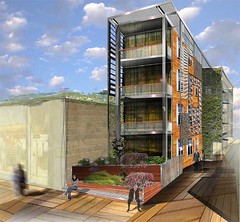 has a terrific introduction to how better walkability can help the city on her firm's web site.
has a terrific introduction to how better walkability can help the city on her firm's web site.
Over-the-Rhine's green advantage won't stop with its location, however. There is a natural synergy between the time-honored design and embodied energy of historic buildings and environmental performance, and many people in the community are committed to making the restoration one that incorporates the latest green building technology, verified by LEED certification. The OTR Foundation has a particularly good statement and introduction to the issue on its website. The Foundation sponsored a design initiative in partnership with the University of Cincinnati's College of Design, Art, Architecture, and Planning, and others, that produced innovative student designs (see rendering above) for green rehabs of OTR properties (scroll down a bit on this site for a nice description).
The neighborhood already has one LEED-certified building, the renovated Art Academy of Cincinnati (above right), and two buildings in the Gateway Quarter project (above left, the facade of the Mottainai) are on track to receive certification this summer. Even a parking lot in the 1500 block of Vine Street has undergone a green renovation, and now has pervious pavement (photo below) to assist stormwater management.
But wait, there's more: the local chapter of the US Green Building Council is inviting students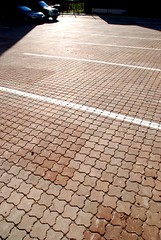 and young professionals to participate in a contest to create a design for a green, upgraded homeless shelter for OTR. And, to top things off (literally), the Findlay Market now has solar panels on its market house roof and last month hosted a forum on green development.
and young professionals to participate in a contest to create a design for a green, upgraded homeless shelter for OTR. And, to top things off (literally), the Findlay Market now has solar panels on its market house roof and last month hosted a forum on green development.
All this energy around making Over-the-Rhine greener is awesome. As I wrote at the beginning of this series, the neighborhood has a long way to go. Much of it remains downtrodden, and It can't help that the economy is stuck in the gutter at the moment. But, if you can't get excited about what's happening in OTR, maybe you just aren't that interested in helping people, cities, or the environment. OK, that's a little over the top, but the point stands: this is terrific stuff, and other cities could do well to learn from what's happening here.
I ran across a lot of great neighborhood resources while researching this series and either I or helpful commenters managed to mention and/or link to most of them. Some that I didn't, but will now, include the Somewhere Over the Rhine blog, City Kin (not just about OTR), iRhine.com, and some very neat Hopper-esque paintings by Alan Grizzell. Special thanks to Jim Uber for the original inspiration for the series.
And, finally, because this is my blog and I can: Speaking of things inspirational, I absolutely love the music of Cincinnati natives Linford Detweiler and Karin Bergquist, the couple who named their band Over The Rhine (credit to Merry R. for the intro some time back) in tribute to the neighborhood. If you like your music with exquisite, contrapuntal keyboard, mournful cello, and plaintive, haunting, and totally committed vocals, here's a sample:

